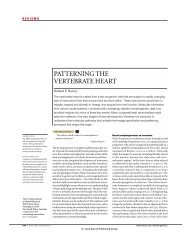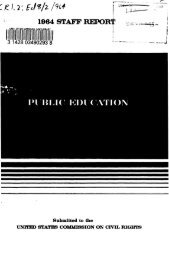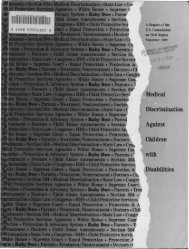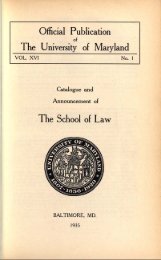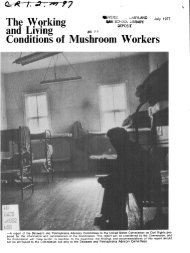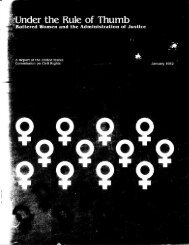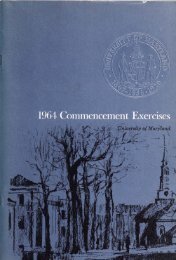1961 US Commission on Civil Rights Report Book 2 - University of ...
1961 US Commission on Civil Rights Report Book 2 - University of ...
1961 US Commission on Civil Rights Report Book 2 - University of ...
Create successful ePaper yourself
Turn your PDF publications into a flip-book with our unique Google optimized e-Paper software.
Curriculum disparities as between white and Negro high schools, another<br />
classic measure <strong>of</strong> tangible inequality, has led to an order to admit<br />
a Negro to a white school, even though the pupil was not eligible for<br />
admissi<strong>on</strong> under a court-approved plan. 110<br />
These decisi<strong>on</strong>s seem sound in theory because the rati<strong>on</strong>ale <strong>of</strong> the<br />
School Segregati<strong>on</strong> Cases seems to be that where tangible equality exists,<br />
the public interest in an orderly transiti<strong>on</strong> may outweigh the plaintiff's<br />
pers<strong>on</strong>al rights. But where there is tangible inequality, the plaintiff's<br />
rights may have greater weight. A difficult situati<strong>on</strong> could arise, however,<br />
if a large number <strong>of</strong> Negro pupils demanded immediate admissi<strong>on</strong><br />
to white schools <strong>on</strong> this ground. In spite <strong>of</strong> the inherent difficulties,<br />
voluntary acti<strong>on</strong> to admit large numbers <strong>of</strong> Negroes to white schools<br />
was taken in the first years after the School Segregati<strong>on</strong> Cases in some<br />
States, notably Oklahoma and Kentucky, up<strong>on</strong> the closing <strong>of</strong> substandard<br />
Negro schools. Such voluntary recogniti<strong>on</strong> <strong>of</strong> the inequalities in<br />
the existing Negro schools seems, however, to be a thing <strong>of</strong> the past.<br />
Immediate general admissi<strong>on</strong> may also be required even when schools<br />
are equal in tangible respects. In Cooper v. Aar<strong>on</strong> 1U when the court<br />
said that in many locati<strong>on</strong>s, obedience to the c<strong>on</strong>stituti<strong>on</strong>al duty to desegregate<br />
"would require the immediate general admissi<strong>on</strong> <strong>of</strong> Negro<br />
children," 112 it apparently went bey<strong>on</strong>d mere tangible inequality, referring<br />
to all cases where administrative difficulties did not warrant<br />
delay.<br />
Recently, complete and immediate desegregati<strong>on</strong> has occurred mainly<br />
in schools serving dependents <strong>of</strong> military pers<strong>on</strong>nel where the number<br />
<strong>of</strong> Negro students was not large. Both by court order 113 and by voluntary<br />
acti<strong>on</strong> 114 <strong>on</strong> the part <strong>of</strong> school authorities, in some places all schoolage<br />
children <strong>of</strong> Negro military pers<strong>on</strong>nel have been admitted to the<br />
<strong>of</strong>f-base school serving dependents <strong>of</strong> white pers<strong>on</strong>nel.<br />
The Court <strong>of</strong> Appeals for the Third Circuit in Evans v. Ennis 115<br />
recognized the need for immediate, general admissi<strong>on</strong> <strong>of</strong> all Negro pupils<br />
seeking admissi<strong>on</strong> to the white schools in the still segregated school districts<br />
in Delaware. It rejected a grade-a-year plan approved by the<br />
district court and insisted up<strong>on</strong> a plan that would provide for the<br />
immediate admissi<strong>on</strong> to white schools in all grades <strong>of</strong> all Negro children<br />
who desired it, in the fall <strong>of</strong> <str<strong>on</strong>g>1961</str<strong>on</strong>g> and thereafter. The court distinguished<br />
the situati<strong>on</strong> in Delaware from that in Nashville where a 12-year<br />
plan had been approved by the courts: 116<br />
32<br />
Many <strong>of</strong> the school districts and high school areas <strong>of</strong> Delaware with<br />
which we are c<strong>on</strong>cerned are in rural or semirural areas, and the<br />
number <strong>of</strong> presently segregated Negro schoolchildren involved in<br />
the whole <strong>of</strong> Delaware is much less than the number involved at<br />
Nashville. Integrati<strong>on</strong> problems are more difficult <strong>of</strong> soluti<strong>on</strong> in<br />
heavily populated urban areas.




